Clinical efficacy observation of ‘Tong Du Yun Pi’manipulation for infantile diarrhea in autumn
Wang Kun-xiu (王昆秀), Luo Zhi-hui (罗志辉), Yan Peng (闫鹏), Tian Ling-ling (田玲玲), Xu Chi-cheng (徐驰成),Chen Bo-lin (陈柏霖), Chen Song (陈松),
1 Hubei University of Chinese Medicine, Wuhan 430061, China
2 Jingzhou Second People’s Hospital, Hubei Province, Jingzhou 434000, China
Abstract
Keywords: Tuina; Massage; Pediatric Massage (Tuina); Immunoglobulins; Diarrhea, Infantile; Autumn
Diarrhea is a common digestive condition in infants and often happens in autumn and winter. The manifestations include increased bowel movement frequency and loose or even watery stool. Infant’s body is not fully developed and their Zang-fu organs are rather delicate. In this case, it is more likely for the external pathogens and improper diet to cause dysfunction of spleen and stomach in transportation and transformation, resulting in diarrhea. Modern medicine takes antivirus, anti-inflammation and rebalancing electrolytes as the major measures for this condition, but usually receiving poor response along with significant adverse effects. As a crucial component of external therapy of traditional Chinese medicine (TCM), pediatric massage (tuina) is easy-to-operate, effective and safe. Its advantages in the treatment of digestive disorders in kids are noticeable. Prof. Wen Qing-han, a famous pediatric massage expert based in Hubei Province, has been engaged in clinical and educating practice for over 50 years, with rich experience. According to kid’s constitution and pathogenesis characteristics, Prof. Wen established ‘Tong Du Yun Pi’ (Governor Vesselunblocking and spleen-promoting) pediatric massage manipulation to treat infantile diarrhea in autumn. To analyze and summarize the operation features and application advantages of this manipulation, we conducted this clinical trial adopting ‘Tong Du Yun Pi’pediatric massage manipulation to treat infantile diarrhea in autumn.
1 Clinical Materials
1.1 Diagnostic criteria
1.1.1 Diagnostic criteria in Western medicine
The Western medicine-based diagnosis and disease severity classification referred the China Diagnosis and Treatment Plan for Diarrhea[1]. Diagnostic criteria:changes in stool form, loose, watery, slimy or even containing blood; more frequent bowel movements than usual. Disease severity classification: no dehydration or poisoning symptoms, mild type; presenting with certain dehydration or mild poisoning symptoms, moderate type; severe dehydration or significant poisoning symptoms (irritated, sluggish, drowsy, pale complexion,high fever or normal body temperature, increased peripheral white blood cell count, etc.), severe type.
1.1.2 Diagnostic criteria in TCM
TCM-based diagnosis and pattern differentiation referred the Diagnosis and Treatment Guideline for Infantile Diarrhea in Traditional Chinese Medicine[2].Diagnostic criteria: marked increase in both bowel movement frequency and volume; pale yellow, yellowish green, brownish, or watery stool, may contain milk lumps or other undigested food, presenting as a mixture of liquid and solid, mushy, or with mucus; filthy stool; the accompanied symptoms include nausea and vomiting,abdominal pain, fever, poor appetite, thirsty, and less urine. In severe cases, there can be manifestations of dual impairment of qi and yin or collapse of yang following exhaustion of yin. Pattern differentiation:wind-cold pattern, spleen deficiency pattern or yang deficiency of spleen and kidney pattern.
1.2 Inclusion criteria
In line with the above diagnostic criteria in both Western medicine and TCM; duration within 14 d; age ≤7 years old; the guardian of the kid agreed to participate in the trial and signed informed consent form.
1.3 Exclusion criteria
Diarrhea caused by bacillary dysentery or other gastrointestinal diseases; serious condition presenting with severe diarrhea and dehydration; already adopted other medications to manage the condition; those with liver or kidney injuries or severe congenital diseases;those unable to cooperate with the therapist.
1.4 Reject and dropout criteria
Failed to complete the examinations; those who quit halfway or withdrew from the trial; failed to follow the treatment plan; those who underwent serious adverse events or developed severe adverse reactions; those whose condition was greatly aggravated or who developed other coupled diseases.
1.5 Statistical methods
SPSS 22.0 statistical software was used for statistical analysis. The measurement data with normal distribution and homogeneous variation were expressed as mean ± standard deviation (±s), and examined using paired samplest-test in intra-group comparisons and two independent samplest-test in between-group comparisons; if homogeneous variation was not met,t’-test would be adopted; when the data were not normally distributed, non-parametric test was used. Enumeration and ranked data were expressed as percentage (%) and examined using Chi-square test.P<0.05 indicated statistical significance.
1.6 General data
A total of 84 infants with autumn diarrhea voluntarily going to receive treatment were enrolled from the rehabilitation outpatients of Jingzhou Second People’s Hospital, Hubei Province between September 1, 2019 and December 31, 2019. They were numbered and randomized into an observation group and a control group using random number table method at a ratio of 1:1, with 42 cases in each group. Each number with its corresponding treatment plan was concealed in opaque envelopes independently and the therapist would offer treatment accordingly. The person who was in charge of recording, evaluation and data analysis was not involved in study design or treatment. The two groups were statistically equal comparing the general data including gender, age and disease duration (allP>0.05), suggesting the comparability (Table 1).

Table 1. General data of the two groups
2 Treatment Methods
2.1 Observation group
2.1.1 Pharmaceutical treatment
Montmorillonite powder [specification: 3 g/package,State Food and Drug Administration Approval No.H20000690, Beaufour-Ipsen (Tianjin) Pharmaceutical Co.,Ltd., China], oral administration: children under 1 year, 1 package daily; 1-2 years old, 1-2 packages each day;above 2 years old, 2-3 packages each day split into 3 times. Three-day treatment was taken as 1 treatment course and 2 courses were observed with a 1-day interval between the 2 courses.
2.1.2 ‘Tong Du Yun Pi’ pediatric massage treatment
Step one: Kai-opening Tianmen. While kid was in a supine position, the doctor Tui-pushed from Yintang(GV 29) till Xinhui (GV 22) with the thumb belly for 36 times (Figure 1).
Step two: Rou-kneading Baihui (GV 20). The doctor Rou-kneaded Baihui (GV 20) clockwise with the thumb belly for 3 min (Figure 2).
Step three: Mo-rubbing the abdomen. The doctor placed his right palm at child’s navel and Mo-rubbed the whole abdomen clockwise with attention focusing on Shenque (CV 8) for 3 min (Figure 3).
Step four: Rou-kneading Guiwei. Child took a prone position. The doctor placed his thumb belly at child’s coccyx and the rest four fingers on child’s sacrum and then Rou-kneaded Guiwei anticlockwise for 3 min(Figure 4).
Step five: Nie-pinching the spine and Kou-tapping the Governor Vessel. Child took a prone position. The doctor Nie-pinched child’s back along the Governor Vessel [from Guiwei till Dazhui (GV 14)] for 7 times, at a rhythm of 1 lift every 3 pinches. Afterward, the doctor closed and naturally bent his fingers to Kou-tap the treated areas for 3 times (Figure 5-Figure 6).
Pediatric massage treatment was performed once a day, 3 d as one treatment course, for 2 courses in total with a 1-day interval between the 2 courses.
2.2 Control group
Children in the control group only took montmorillonite powder, following the same dose and treatment course as in the observation group.

Figure 1. Kai-opening Tianmen
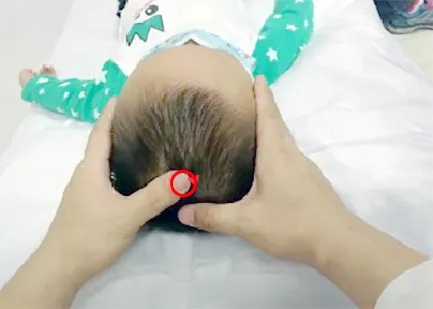
Figure 2. Rou-kneading Baihui (GV 20)
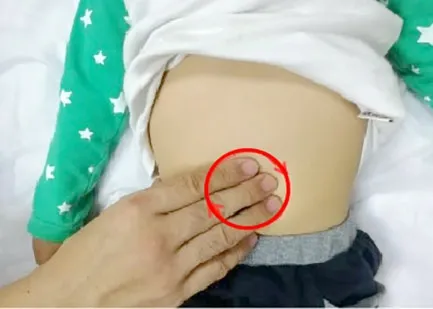
Figure 3. Mo-rubbing the abdomen
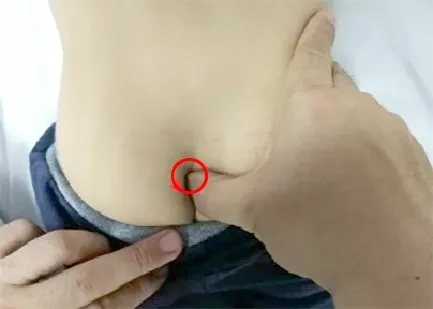
Figure 4. Rou-kneading Guiwei
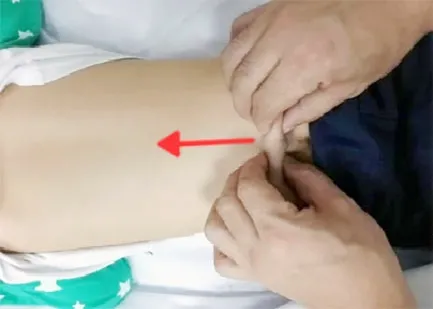
Figure 5. Nie-pinching the spine

Figure 6. Kou-tapping the Governor Vessel
3 Observation of Therapeutic Efficacy
3.1 Observation items
3.1.1 TCM-based symptoms scores
The TCM-based symptoms were scored according to theGuiding Principles for Clinical Study of New Chinese Medicinesbefore and after treatment[3]. The details are shown in Table 2.
3.1.2 Improvement times of the symptoms among the effective cases
The improvement time of bowel movement, relieving time of abdominal bloating, the time that vomiting ceased and the time fever was brought down among the effective cases in both groups were recorded.
3.1.3 Immune function indicators
The FACSVia flow cytometer (Shanghai Jumu Medical Instrument Co., Ltd., China) was used to detect the levels of CD4+and CD8+in the kids before and after treatment.
Specific protein analyzer (Shijiazhuang Hebai Biotechnology Co., Ltd., China) was adopted to determine the levels of serum immunoglobulin (Ig) G and IgM before and after treatment.
The above tests all strictly followed the operation instructions.

Table 2. Scoring criteria of TCM-based symptoms
3.2 Therapeutic efficacy criteria
In this study, efficacy was evaluated according to the efficacy criteria for diarrhea in theGuiding Principles for Clinical Study of New Chinese Medicines[3]and the reduction rate of TCM symptoms scores.
Reduction rate of TCM symptoms scores = (Pretreatment TCM symptoms scores - Post-treatment TCM symptoms scores) ÷ Pre-treatment TCM symptoms scores × 100%.
Cured: Formed stool, once a day; stool routine examination showed normal; the accompanied symptoms were substantially gone; the reduction rate of TCM symptoms scores ≥90.0%.
Markedly effective: Substantially formed stool, 2-3 times a day; stool routine examination showed improvement; the accompanied symptoms relapsed accidentally but were reduced and mild; the reduction rate of TCM symptoms scores ≥70.0% but <90.0%.
Effective: Bowel movement frequency and stool form were improved; stool routine examination showed certain improvement; aggravated diarrhea and accompanied symptoms due to change of climate or improper diet; the reduction rate of TCM symptoms scores ≥30.0% but <70.0%.
Invalid: The symptoms were worsened instead of improved; no improvement in stool routine examination;the reduction rate of TCM symptoms scores <30.0%.
3.3 Results
3.3.1 Comparison of clinical efficacy
The total effective rate was 95.2% in the observation group, higher than 76.2% in the control group, and the between-group difference was statistically significant(P<0.05), (Table 3).
3.3.2 Comparison of TCM symptoms scores
There were no significant differences in the scores of stool form, bowel movement frequency, poor appetite,abdominal bloating and sluggish between the two groups prior to treatment (allP>0.05), indicating the comparability. After treatment, the scores of the above items all declined in both groups, presenting significant intra-group differences (allP<0.05); the scores of the above items were lower in the observation group than in the control group (allP<0.05), indicating improvement of symptoms in both groups and the improvement was more notable in the observation group (Table 4).
3.3.3 Comparison of the symptom improvement time among the effective cases
After treatment, the times to restore normal defecation, relieve abdominal bloating, and cease vomiting and fever were shorter in the observation group than in the control group, and the between-group differences were statistically significant (allP<0.05),(Table 5).
3.3.4 Comparison of immune function
There were no significant differences in the levels of IgG, IgM, CD4+, CD8+, and CD4+/CD8+between the two groups prior to treatment (allP>0.05), indicating the comparability. After treatment, the level of CD8+dropped, and the levels of IgG, IgM, CD4+and CD4+/CD8+increased in both groups (allP<0.05); the levels of IgG,IgM, CD4+, CD8+and CD4+/CD8+in the observation group were significantly different from those in the control group (allP<0.05), (Table 6).

Table 3. Comparison of clinical efficacy between the two groups (case)
Table 4. Comparison of TCM symptoms scores (±s, point)

Table 4. Comparison of TCM symptoms scores (±s, point)
Note: Compared with the same group before treatment, 1) P<0.05; compared with the control group, 2) P<0.05
Abdominal bloating Sluggish Observation 42 Pre-treatment 4.32±0.61 4.34±0.91 1.68±0.24 1.50±0.34 1.40±0.35 Post-treatment 1.21±0.261)2) 1.16±0.591)2) 0.54±0.331)2) 0.73±0.301)2) 0.53±0.311)2)Control 42 Pre-treatment 4.21±0.33 4.22±0.82 1.55±0.37 1.44±0.32 1.31±0.40 Post-treatment 2.14±0.411) 1.97±0.741) 0.97±0.261) 0.90±0.301) 0.78±0.291)
Table 5. Comparison of symptom improvement times in the effective cases (±s, day)

Table 5. Comparison of symptom improvement times in the effective cases (±s, day)
Note: Compared with the control group, 1) P<0.05
Group n Normal bowel movement Relief of abdominal bloating Cease of vomiting Relief of fever Observation 40 2.86±1.741) 2.64±0.711) 1.59±0.651) 1.74±0.821)Control 32 4.22±1.63 4.03±0.89 2.25±0.86 3.24±0.35
Table 6. Comparison of immune function (±s)

Table 6. Comparison of immune function (±s)
Note: Compared with the same group before treatment, 1) P<0.05; compared with the control group after treatment, 2) P<0.05
CD8+ (%) CD4+/CD8+Observation 42 Pre-treatment 7.94±2.49 1.66±0.35 32.63±2.57 31.08±2.14 1.05±0.20 Post-treatment 14.36±2.141)2) 1.98±0.581)2) 40.02±2.311)2) 21.75±2.021)2) 1.84±0.251)2)Control 42 Pre-treatment 7.89±2.36 1.54±0.30 33.62±2.12 30.56±2.35 1.10±0.22 Post-treatment 11.69±2.311) 1.78±0.461) 34.71±2.271) 25.45±2.231) 1.36±0.181)
4 Discussion
Infantile diarrhea in autumn belongs to the scope of diarrhea in TCM and mainly affects the spleen. The spleen is situated in the middle energizer, serving as a pivot of the ascending and descending of qi activities. Its normal function guarantees the production of qi and blood to nourish the whole body. When the spleen is too deficient to maintain its normal function, or the life-gate fire is too weak to support the spleen, the ascending and descending of qi activities will lose control, so that the clear and the turbid can’t be separated and pour downward together causing diarrhea. Kid’s Zang-fu organs are rather delicate. The wind-cold pathogens in autumn and winter seasons tend to damage yang qi. If it is the middle energizer that is directly invaded, the spleen and stomach will lose the control of ascending the clear and descending the turbid, finally resulting in the accumulation of dampness, leading to diarrhea. Yang qi can protect against the external pathogens and warm and nourish the internal Zang-fu organs. Normal qi activities maintain the health of human body. The Governor Vessel is the sea of yang meridians, vertically passing through the middle of the back, and considered as the root of yang qi[4]. Prof. Wen holds that meridian qi of the Governor Vessel can pour into the parallel Back-Shu points, so as to connect with the corresponding Zang-fu organs and regulate their functions; it can also strengthen yang qi to modulate and unblock qi activities and promote kid’s body resistance. Ordinary pediatric massage manipulations can help with diarrheal symptoms but it’s not well-directed[5], while ‘Tong Du Yun Pi’ pediatric massage manipulation can improve kid’s constitution, targeting both the superficial manifestations and the root cause, and produce more significant efficacy.
The key pathogenesis of infantile diarrhea in autumn should be the dysfunction of deficient spleen together with the invasion of external pathogens resulting in accumulation of dampness[6]and consequent diarrhea.It is a disease deficient in the root and excess in the superficial. Prof. Wen treats it with ‘Tong Du Yun Pi’pediatric massage manipulation and achieves magnificent results. The effectiveness may be associated with the following factors.
First, it is the selection of acupoints. As one of the common starting manipulations, Kai-opening Tianmen can release the pathogens at the superficial level by promoting sweating, open the orifices to awaken the mind, and unblock and regulate yang qi of the Governor Vessel to activate the flow of meridian qi. Rou-kneading Baihui (GV 20) can influence the overall yang qi to lift up the descended, manifesting the theory that select the acupoints from the higher part of the body for diseases affecting the lower part[7]. Mo-rubbing the abdomen can tonify the spleen to improve its function, strengthen yang qi to cease diarrhea, directly targeting the affected organ. Guiwei is situated at the origin of Governor Vessel.Rou-kneading Guiwei can ascend yang qi and regulate qi activities to stop diarrhea. Combining this manipulation with Mo-rubbing the abdomen is similar to the compatibility of Back-Shu and Front-Mu points. Niepinching the spine and Kou-tapping the Governor Vessel works to rouse the yang qi of the Governor Vessel and Bladder Meridian, harmonize yin and yang, and promote the circulation of qi and blood throughout the body. The whole prescription of pediatric massage manipulation aims to unblock and modulate the meridian qi of Governor and Conception Vessels to assist the function of spleen and stomach, dispelling dampness and stopping diarrhea.
Second, it is the operation of manipulations. It may seem rather simple that Prof. Wen’s manipulations. In fact, there is much more profound theory behind it. For example, the standard location of Tianmen is the line from the midpoint between the eyebrows till the anterior hairline[8]. But, Prof. Wen usually Tui-pushes till Xinhui (GV 22) when performing this manipulation, to strengthen the effect of dispelling pathogenic qi, as well as to calm the mind and refresh the brain, and elevate yang qi to improve kid’s spirit. Mo-rubbing the abdomen is a part of the routine pediatric massage manipulation for diarrhea. Shenque (CV 8), located at the center of the abdomen as the postnatal pivot of enfants, connects closely with the Thoroughfare, Conception, Governor and Belt Vessels. With the full attention of the practitioner laid on this acupoint during preformation, it can help consolidate the foundation and cultivate the Yuan-Primordial qi and produce more significant efficacy[9-10], which is quite similar to the Taoist skill of guarding Dantian with the attention. Moreover, properly increasing the friction when Nie-pinching the spine to make the skin flush with heat can promote the circulation of qi and blood, and dispel the pathogens at the superficial level by sweating. This manipulation is often conducted for 7 times, which signifies using yang number in supporting the healthy qi.
Third, it is to treat both the superficial manifestations and root cause. Dampness is generated when the spleen is deficient. The external pathogens will combine with dampness when invading inside. Therefore, dispelling the pathogens should be considered together with supporting the healthy qi. Inspired by the theory of‘pulling the boat against the current’ in the treatment of dysentery and considering the features of diarrhea in autumn, Prof. Wen stresses to drive away the pathogens with sweating, so as to release the superficial manifestations and harmonize the internal. Kids often experience a mild sweat all over the body after the first session, followed by the release of fever and improvement of symptoms on the same day. In this study,the scores of TCM symptoms including stool form, bowel movement frequency, poor appetite, abdominal bloating and sluggish were significantly lower in the observation group than in the control group after treatment, and the total effective rate was also higher in the observation group, suggesting that combining ‘Tong Du Yun Pi’ manipulation with Western medication works better in mitigating symptoms and promoting the recovery than using the Western medication alone.
Fourth, it is the emphasis on ‘spirit management’[11].‘Spirit management’ has three meanings: one, it refers to management of the spirit of the doctor; two, it is the management of the spirit of kid; three, it means the management of kid’s primordial spirit. Prof. Wen stresses that the practitioner should be single-minded without any distraction during treatment, closely paying attention to the spiritual status of the kid to adjust the force of manipulation whenever necessary, which helps to judge the development and prognosis of the disease.Besides, since the Governor Vessel runs up to the crown of the head, so unblocking the Governor Vessel and regulating the meridian qi can increase the pouring of meridian qi of the fourteen meridians and assist to transport the essence and qi of Zang-fu organs to the brain, so that the primordial spirit can fully play its role in the overall modulation[12-13]. In this study, the observation group took shorter times in restoring normal bowel movement, releasing abdominal bloating,stopping vomiting, and relieving fever than the control group, suggesting that ‘Tong Du Yun Pi’ manipulation can trigger the qi of primordial spirit in kids, and promote clinical efficacy and shorten disease duration through a dual effect of elevating the healthy qi and dispelling pathogenic qi.
Fifth, it is the findings of modern research. The Governor Vessel runs through the spine, where the extended nerve roots dominate the movements of internal organs and limbs. Research found that the persistent effective stimulation produced by pediatric massage can regulate the function of Zang-fu organs through the corresponding nerve segments[14-17]. For example, Nie-pinching the spine can either excite or inhibit the gastrointestinal smooth muscles to regulate the gastrointestinal peristalsis and improve the digestive function, thus to reduce the occurrence of diarrhea; Roukneading Guiwei can modulate the autonomic nervous system of anus to promote the development of sphincter and levator ani muscles of enfants, so as to treat diarrhea.Moreover, the immune system is not well-developed in younger children[18-21], which is another crucial factor in the development of diarrhea. Therefore, strengthening the immune function can also effectively prevent and treat diarrhea in enfants. IgG, IgM and CD4+/CD8+are considered as important indicators in evaluating cellular immune function. The current study found that the levels of IgG, IgM and CD4+/CD8+were higher and CD8+was lower in the observation group than in the control group after treatment, manifesting that ‘Tong Du Yun Pi’manipulation can significantly improve kids’ immune function and thus effectively control the disease.
To conclude, ‘Tong Du Yun Pi’ pediatric massage manipulation is worth promoting in clinical practice as it can recover the overall qi activities via focusing on unblocking and regulating yang qi of the Governor Vessel to help restore the function of spleen, and produce valid efficacy in treating infantile diarrhea in autumn.
Conflict of Interest
There is no potential conflict of interest in this article.
Acknowledgments
This work was supported by Young Talents Development Program of Hubei Province (湖北省青年英才开发计划);Traditional Chinese Medicine Master Studio Project of Hubei (湖北中医名师工作室项目); 2019 Medical and Health Science and Technology Project in Jingzhou City (荆州市2019 年医疗卫生科技计划项目, No. 2019HC51);2019 ‘Traditional Chinese Medicine Inheritance and Innovation Plan’ Project of Hubei University of Chinese Medicine (2019 年度湖北中医药大学“中医药传承创新计划”项目).
Statement of Informed Consent
Informed consent was obtained from the guardians of the recruited children in this study.
Received: 29 August 2020/Accepted: 19 December 2020
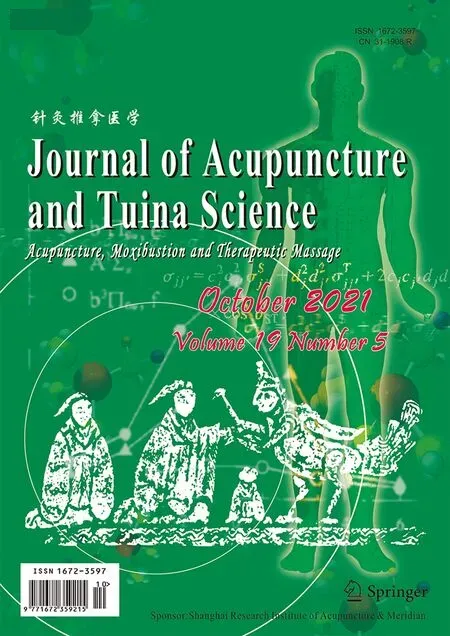 Journal of Acupuncture and Tuina Science2021年5期
Journal of Acupuncture and Tuina Science2021年5期
- Journal of Acupuncture and Tuina Science的其它文章
- Exploring the effect of acupuncture plus mild hypothermia on miRNA-204 and its target gene expressions in CIRI rat brain tissues based on MAPK signal pathway
- Experimental observation of effects of acupoints,cone numbers and durations of moxibustion with different moxibustion methods on skin surface and inside temperature
- Therapeutic massage for knee osteoarthritis:a systematic review and meta-analysis of randomized controlled trials
- Clinical observation on moxibustion therapy plus tuina in treating children with recurrent respiratory tract infections due to qi deficiency of spleen and lung
- Effects of acupuncture plus language training on language function and cerebral blood flow in patients with motor aphasia after ischemic stroke
- Efficacy and effect on related brain-gut peptides of acupoint sticking therapy for functional dyspepsia
